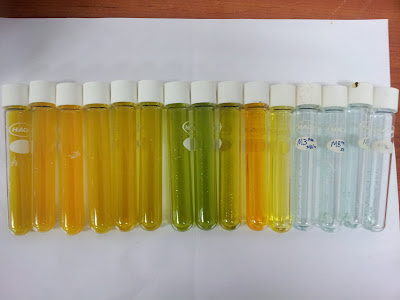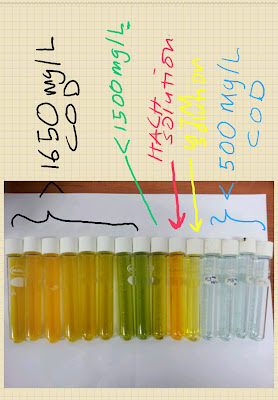
 OXYGEN DEMAND, CHEMICAL For water, wastewater and seawater
OXYGEN DEMAND, CHEMICAL For water, wastewater and seawaterReactor Digestion Method* USEPA approved for reporting wastewater analysis**
dIGESTION
1. Homogenize 500 mL of sample for 2 minutes in a blender.
Note: For the 0-15,000 mg/L range, homogenize 100 mL of sample.
Pour the blended sample into a 250-mL beaker.
Stir with a magnetic stirrer while withdrawing a sample aliquot.
This improves accuracy and reproducibility.
2. Turn on the DRB200 Reactor. Preheat to 150 °C.
Note: See DRB 200 user manual for selecting pre-programmed temperature applications.
3. Remove the cap of a COD Digestion Reagent Vial.
4. Hold the vial at a 45-degree angle.
Pipet 2.00 mL (0.2 mL for the 0 to 15,000 mg/L range) of sample into the vial.
5. Replace the vial cap tightly.
Rinse the outside of the COD vial with deionized water and wipe the vial clean with a paper towel.
6. Hold the vial by the cap and over a sink.
Invert gently several times to mix the contents.
Place the vial in the preheated DRB200 Reactor.
Note: The vial will become very hot during mixing.
7. Prepare a blank by repeating Steps 3 to 6, substituting 2.00 mL (0.2 mL for the 0 to 15,000 mg/L range) deionized water for the sample.
Note: Be sure the pipet is clean.
8. Heat the vials for 2 hours.
Note: Many samples are digested completely in less than two hours.
If desired, measure the concentration (while still hot) at 15 minute intervals until the reading remains unchanged.
Cool vials to room temperature for final measurement.
9. Turn the reactor off.
Wait about 20 minutes for the vials to cool to 120 °C or less.
10. Invert each vial several times while still warm.
Place the vials into a rack.
Wait until the vials have cooled to room temperature.
Note: If a pure green color appears in the reacted sample, measure the COD and, if necessary, repeat the test with a diluted sample.
11. Use one of the following analytical techniques to measure the COD:
•Colorimetric method, 0-150 mg/L COD
•Colorimetric method, 0-1,500 mg/L COD
•Colorimetric method, 0-15,000 mg/L COD
Colorimetric Determination, 0 to 150 mg/L COD
1. Enter the stored program number for chemical oxygen demand (COD), low range.
Press: PRGM
The display will show:PRGM?
2. Press: 16 ENTER
The display will show mg/L, COD and the ZERO icon.
Note: For alternate form (O2), press the CONC key.
3. Insert the COD/TNT Adapter into the cell holder by rotating the adapter until it drops into place.
Then push down to fully insert it.
Note: For increased performance, a diffuser band covers the light path holes on the adapter. Do not remove the diffuser band.
4. Clean the outside of the blank with a towel.
Note: Wiping with a damp towel, followed by a dry one, will remove fingerprints or other marks.
5. Place the blank in the adapter.
Push straight down on the top of the vial until it seats solidly into the adapter.
Note: Do not move the vial from side to side as this can cause errors.
6. Tightly cover the vial with the instrument cap.
Note: The blank is stable when stored in the dark.
See Blanks for Colorimetric Determination following these procedures.
7. Press: ZERO
The cursor will move to the right, then the display will show:0 mg/L COD
8. Clean the outside of the sample vial with a towel.
9. Place the sample vial in the adapter.
Push straight down on the top of the vial until it seats solidly into the adapter.
10. Tightly cover the vial with the instrument cap.
11. Press: READ
The cursor will move to the right, then the result in mg/L COD will be displayed.
Colorimetric Determination, 0 to 1,500 and 0 to 15,000 mg/L COD
1. Enter the stored program number for chemical oxygen demand (COD), low range.
Press: PRGM
The display will show:PRGM?
2. Press: 17 ENTER
The display will show mg/L, COD and the ZERO icon.
Note: For alternate form (O2), press the CONC key.
3. Insert the COD/TNT Adapter into the cell holder by rotating the adapter until it drops into place.
Then push down to fully insert it.
Note: For increased performance, a diffuser band covers the light path holes on the adapter. Do not remove the diffuser band.
4. Clean the outside of the blank with a towel.
Note: Wiping with a damp towel, followed by a dry one, will remove fingerprints or other marks.
5. Place the blank in the adapter.
Push straight down on the top of the vial until it seats solidly into the adapter.
Note: Do not move the vial from side to side as this can cause errors.
6. Tightly cover the vial with the instrument cap.
Note: The blank is stable when stored in the dark.
See Blanks for Colorimetric Determination following these procedures.
7. Press: ZERO
The cursor will move to the right, then the display will show:0 mg/L COD
8. Clean the outside of the sample vial with a towel.
9. Place the sample vial in the adapter.
Push straight down on the top of the vial until it seats solidly into the adapter.
10. Tightly cover the vial with the instrument cap.
11. Press: READ
The cursor will move to the right, then the result in mg/L COD will be displayed.
Note: When using High Range Plus COD Digestion Reagent Vials, multiply the reading by 10.
Note: For most accurate results with samples near 1,500 or 15,000 mg/L COD, repeat the analysis with a diluted sample.
Sampling and Storage
Collect samples in glass bottles.
Use plastic bottles only if they are known to be free of organic contamination.
Test biologically active samples as soon as possible.
Homogenize samples containing solids to assure representative samples.
Samples treated with sulfuric acid to a pH of less than 2 (about 2 mL per liter) and refrigerated at 4 °C can be stored up to 28 days.
Correct results for volume additions; see Correction for Volume Additions (Section 1) for more information.
Accuracy Check
Standard Solution Method
Check the accuracy of the 0 to 150 mg/L range with a 100 mg/L standard.
Prepare by dissolving 85 mg of dried (120 °C, overnight) potassium acid phthalate (KHP) in 1 liter of deionized water.
Use 2.0 mL as the sample volume.
The expected result will be 100 mg/L COD.
As an alternative, dilute 10 mL of 1000-mg/L COD Standard Solution to 100 mL to make a 100-mg/L standard.
Check the accuracy of the 0 to 1,500 mg/L range by using either a 300 mg/L or 1000 mg/L COD Standard Solution.
Alternatively, prepare a 500 mg/L standard by dissolving 425 mg of dried (120 °C, overnight) KHP.
Dilute to 1 liter with deionized water.
Use 2.0 mL of one of these solutions as the sample volume.
Check the accuracy of the 0 to 15,000 mg/L range by using a 10,000 mg/L COD standard solution.
Prepare the 10,000 mg/L solution by dissolving 8.500 g of dried (120 °C, overnight





Assalamualaikum puan, saya asikin, berkhidmat dalam bidang waste water. saya berminat dengan info puan mengenai COD test. Tapi saya mempunyai satu kemusykilan, saya berharap puan dapat membantu. Selepas memanaskan cod vial selama 2 jam dengan suhu 150 degree C, satu lapisan seperti lemak muncul dalam vial semasa cool down process. Apakah ini mengganggu result saya?. Adakah ini salah satu interference selain chloride?
ReplyDelete